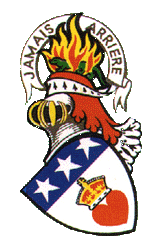|
Andrew
Spratt contributes:
Some
two miles from Peterhead on the north east coast of Scotland, on a hill
above the river Ugie sits a small mound only three metres high. This is
all that remains of the first wooden 'Motte and Bailey' castle of
Inverugie raised by the Cheynne family in the 12th century. The name
'Inver ' means beside or on usually with reference to a river. Hence
Inver-Ugie is, simply put, the castle beside the river Ugie.
Such
early wooden castle structures usually consisted of a high mound (Motte)
capped by a wooden palisade around a tall wooden tower with angled roof
covered in animal hides to help make it semi fire resistant. The palisade
and tower beams were covered in a layer of cow urine and clay to help
resist attacks by incendiary arrows and fiery faggots (bales of tightly
packed straw around a core of goose grease with a wick fuse set ablaze
then launched from catapults). Theoretically the cow urine/clay mix would
crack off with the intense heat of such attacks leaving the vulnerable
wood beneath unscathed.
Below
the Motte by way of a narrow foot bridge was the Bailey which was likewise
surrounded by a wooden palisaded ditch. Within the bounds of the Bailey
would be the banquet hall, stables ,barracks, brewhouse, grain barns etc
all of wood and wattle construction with thatched roofs. The Bailey
palisade would have been used to protect cattle from surrounding farms
during times of war and siege. During lengthy sieges the livestock could
be slaughtered to provide the garrison with fresh meat. The position of
the Motte relative to the river Ugie suggests it protected the ford
crossing at this point and that the Bailey ditch would have been flooded
with water from the Ugie for added defence.
In
the mid 14th century the estate of Inverugie passed to the Keith Earl
Marishals who's main seat was the coastal fortress of Dunnottar
castle near Stonehaven south of Aberdeen. They built the present
ruined stone castle of Inverugie to the south of the original wooden Motte
around 1660. Though there must have been an intermediate towerhouse on or
near the site of the present ruin. As it would be ridiculous to suggest
the Keiths would reside in the Cheynne's dilapidated cow urine/clay washed
Motte tower for three centuries before considering building a more up to
date dwelling place.
The
present ruined stone castle was built by the 4th Earl Marischal as a more
comfortable seat to Dunnottar since it's devastation by Oliver Cromwell in
his failed pursuit of the Scots regalia used to crown King Charles II.
Inverugie was a long oblong tower house four storeys high with crowstepped
gables of mixed rubble construction. Which suggests the incorporation of
materials taken from an earlier stone building. There were also two large
conical roofed round towers, one at the north-east corner and the other at
the south-east corner. This was an odd plan, usually such round towers
were set at diagonal corners in the classic Z-plan arrangement. On the
middle of the west side was a third narrow tower containing the main
turnpike staircase. This faced out to the cobbled courtyard with it's
enclosing wall beside the river Ugie. To the south of the site was the
original courtyard entrance with additional buildings possibly built after
1660. Above this entrance was a datestone of 1670 with the coats of arms
of Keith and Douglas of Morton. In the late 1800's an oak carved Heraldry
shield was discovered in a nearby cottage with the arms of William
Keith,7th Earl Marischal and his wife Anna Douglas, the daughter of the
Earl of Morton though it's date was carved as 1660.
The
basement vault of the oblong tower house contained the storage area and
kitchen entered from courtyard level. The next level was the great hall
where the Keiths would have wined and dined their honored guests. In the
north and south corners of the hall were doors to small interior turnpike
stairs accessing both round towers. The remaining two levels were bedrooms
and possibly a chapel. There was also small private apartments in each of
the round towers with extra toilets. Although several of the west facing
windows were large they were protected by metal cages and interior bars
for extra security. There is a distinct lack of gun loops for small arms
fire which is unusual since the 1660's were still troublesome times.
By
the early 1800's Inverugie had passed from the Keiths to a James Ferguson
who apparently kept the building in perfect order until his death in 1820.
It was then ransacked and the roof and flooring stolen. In 1899 for some
long forgotten reason Inverugie was blown up. By who and why is a puzzle.
This is a great shame because the present ruin is little more than one
level high. If it had still been reasonably intact it would have made an
ideal location for a Clan Keith Heritage Centre and grants could have been
sought in restoring such an interesting, historic building.
|


